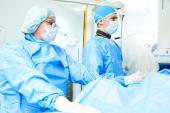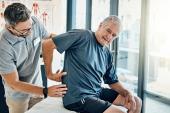Pain in the Neck? Operators Seek Solutions to Lead’s Weighty Toll
Cath labs need to be redesigned so that operators aren’t at risk for future injury, even if it requires some hospital investment.

WASHINGTON, DC—The average cath lab operator spends about one-third of each case with their neck torqued into an unnatural position that puts them at increased risk for cervical injury, the ERGO-CATH study suggests.
Wearing a traditional lead vest/skirt, compared with a leadless approach (Rampart), caused more discomfort when contorted in the same positions and exposed operators to more radiation.
“To me, that is an incredibly sobering number: 34% of the time our cervical spines are in a high-risk position,” said Ajar Kochar, MD (Brigham and Women's Hospital, Boston, MA), in a press conference prior to presenting the study here last week at the Society for Cardiovascular Angiography and Interventions (SCAI) 2025 Scientific Sessions.
The data come on the heels of a SCAI survey showing that the high rate of orthopedic and radiation injuries among operators and their staff have remained unchanged for over a decade. More than 65% of those surveyed said they had experienced musculoskeletal pain related to wearing lead or working in the cath lab, and 60% reported at least one orthopedic injury.
“When we delved into the literature, we realized that there was a real dearth of data in this space,” said Kochar. The increased comfort and clear reduction in radiation with Rampart suggest the need to couple leadless solutions with “dedicated, tailored exercise regimens” to lessen the ergonomic strain that not only causes injury, but can prematurely end interventionalists careers, he said.
Right now, the biggest barriers to adoption of leadless systems are administrative hurdles and cost.
“We as a community need to advocate over this, and costs should not be a barrier to our safety,” he told TCTMD. “If we do more complicated cost-effectiveness studies on the time that interventional cardiologists are stepping away from work, retiring early, I think [we will see] the long-term benefits of investing and protecting not just interventional cardiologists, but all of the staff, so nurses and our techs as well.”
Costs should not be a barrier to our safety. Ajar Kochar
While the data from ERGO-CATH make sense, there’s another piece of the puzzle to consider in why operators’ necks are at risk so much of the time when they are working.
“We badly design cath labs to begin with,” said Bonnie Weiner, MD (Saint Vincent Hospital, Worcester, MA), who chimed in from the audience after Kochar’s presentation. “We depend on the vendors to do it, and don't encourage moving gantries and things that go up and down that can minimize these risks.”
As a shorter-statured operator, Weiner said, she frequently encounters lab setups that were meant for tall men and has had to rearrange them to suit what was comfortable for her. “Not taking into account the physical structure of the cath lab and the relative heights of the various people involved in the case may be missing data that could be valuable,” she added.
Measuring Ergonomic Strain
For the single-center, nonrandomized ERGO-CATH study, Kochar and colleagues looked at various measures of musculoskeletal strain among 20 operators (mean age 41 years; 38% female), when they worked with traditional leaded garb versus the leadless system. The operators, a group including attendings, fellows, and physician assistants, wore electrodes and inertial monitoring units (IMUs) on the cervical, thoracic, torso-pelvic, and lumbar areas of their spine.
Of the 61 cases performed, 45.9% were diagnostic, 36.1% were PCI, and 16.4% were structural. Mean case was time 79.9 minutes.
The study’s primary endpoint was the percentage of time the operator spent working with their head and neck in a position that was outside of the range of their normal posture by more or less than 20 degrees. This included cervical axial rotation (moving the head and neck to the right or left), cervical flexion (bending the head towards the chest), and thoracic flexion (bending forward and rounding of the upper back).
As a group, operators spent 35.8% of the cases in cervical axial rotation, 15.6% in cervical flexion, and 5.7% in thoracic flexion, with similar percentages of these movements seen while wearing traditional lead or the leadless system.
On a modified Cornell musculoskeletal discomfort scale, 43% of operators reported discomfort when wearing lead versus 35% when wearing the leadless system.
As measured with a real-time radiation dose-monitoring system, exposure was five times lower with the leadless system than with traditional lead (0.14 vs 0.73 mrem).
Wearing traditional lead during a procedure adds about 14 pounds to the axial rotation or axial load on the spine independent of the biomechanical forces of movement and flexion, according to Kochar.
Data from the electrodes and IMUs showed that with the leadless system, both mean and peak cervical axial rotation was reduced compared with lead garb, he said. This suggests that the paraspinal muscles at the cervical level are less activated by movements of the head and neck. The reduction is believed to be linked to a lower risk of experiencing microtrauma and fatigue.
A secondary analysis of ERGO-CATH, also presented at SCAI, looked at differences between male and female operators.
Women operators were slightly older than the male colleagues and had higher body mass index (27.6 vs 25.3 kg/m2). Most strikingly, 62.5% of women reported a past orthopedic injury, as compared with 16.5% of men.
While wearing lead, 50% of women operators reported some musculoskeletal discomfort immediately after the case compared with 10% of men, said presenter Raghav Gattani, MBBS (Brigham and Women’s Hospital). When they used the leadless system, only 7.7% of women reported discomfort immediately after the case.
The reductions in radiation exposure with the leadless system versus traditional lead were similar between both sexes.
Kusum Lata, MD (Sutter Health, Tracy, CA), who moderated the session, said she is not convinced Rampart is the solution for every operator. She noted that it can be cumbersome for pregnant operators because the system has to be moved and adjusted while working, and it can be difficult to set up adequately for certain structural and congenital cases involving multiple access sites.
”Hopefully what this pilot study will do is serve as the first step for additional work,” Kochar said. “I think a lot of what we're doing is turning our necks to go get equipment from behind us and so forth.”
After showing a 3D skeletal image of a colleague’s spine and upper body twisted during a typical case, Kochar said more work is needed to understand better design elements for cath labs. This includes practical solutions or workflow modifications for operators to limit the physical strain they may not even recognize they are under during cases.
L.A. McKeown is a Senior Medical Journalist for TCTMD, the Section Editor of CV Team Forum, and Senior Medical…
Read Full BioSources
Kochar A. Orthopedic risks to cardiac catheterization laboratory operators: Insights from ERGO-CATH. Presented at: SCAI 2025. May 1, 2025. Washington, DC.
Disclosures
- ERGO-CATH was funded by a research grant from Rampart.
- Kochar reports grant funding from Shockwave and Rampart; and consulting fees/honoraria from Abiomed and Faraday.





Comments